Alaska Fish & Wildlife News
October 2015
Enhancing Habitat for Moose and Grouse
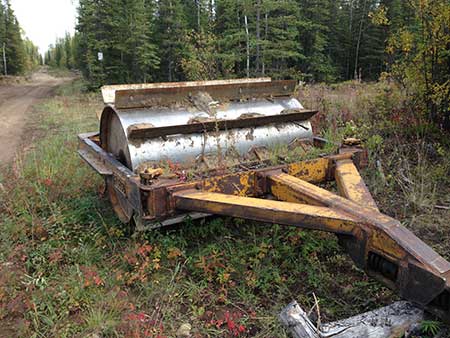
Smashing trees and burning forests may not seem like habitat enhancement. But nature rebounds in the aftermath of what might look like carnage, and that’s often good for wildlife.
Wildland fires are a natural part of the Interior Alaska ecosystem, and plants and animals have adapted to periodic fires. Willow, aspen and birch are nutritious, high-quality forage for moose. They can regenerate and thrive after certain kinds of physical trauma, such as fire or crushing. Lush sprouts emerge from the ground level – gardeners call them root suckers – and quickly grow. Importantly, this new growth is accessible to moose. Plants like fireweed also thrive after fire – and provide good moose food.
Regenerating growth isn't the only benefit of fire. Standing dead trees provide roosts for raptors and homes for cavity nesters such as woodpeckers. Fallen trees provide cover for voles, hares and marten, shelter that's especially valuable in winter.
Wildlife managers and foresters can use prescribed fires as a habitat-enhancement tool to stimulate plant growth. But another natural phenomenon in Alaska also stimulates these plants. During spring break-up, massive chunks of ice are rafted down rivers, scouring riverbanks and gravel bars. Mechanical crushing mimics this process.
Sue Rodman explains how the aptly named roller chopper works.
“The chopper is a big drum that has teeth on it, it’s drug behind the D-9 (tractor). This is done in winter because the cold helps – the bulldozer snaps the trees off at the base, then the roller chopper cuts it up into smaller chunks. So what happens, because of the physiology of aspen, when we cut them all down, their hormone balance changes and they send up root suckers – aspen is all connected underground, like one big organism.”
Rodman has a forestry background and works on habitat enhancement and fire-related projects for Alaska Fish and Game. She’s helping coordinate a number of projects to improve forage quality and quantity, aimed at increasing numbers of moose and ruffed grouse to provide food and hunting opportunities. Moose and ruffed grouse have similar habitat requirements.
Ruffed grouse rely on aspen stands that are a mixture of age classes. The diversity of age classes provides different things to grouse throughout the year. Younger, denser stands of aspen provide excellent cover for broods of chicks in summer, hiding them from predators. Older aged aspens provide breeding and wintering habitat. Like fire, mechanical crushing can create the diversity of habitat that grouse and moose thrive in.
“In winter they’re eating primarily buds and catkins,” said Cameron Carroll, a state wildlife biologist focusing on grouse and small game. “In the fall they eat berries, forbs and such; then in the spring during the breeding season male ruffed grouse are drumming and they need drumming logs and overhead cover from avian predators. Young grouse rely heavily on arthropods in their first few weeks, grasshoppers, good sources of protein. They need good cover as well as food. Cover is huge for these birds, especially in the summer.”
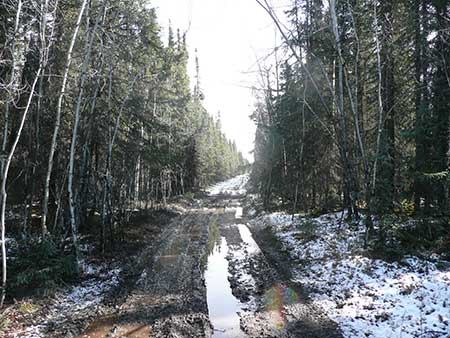
Plans are underway for several habitat enhancement projects, and three in particular are noteworthy. A Tok area project benefitting moose and grouse, a project near Sutton in Southcentral to benefit moose and grouse, and a project on the Kenai near Sterling to benefit moose – and provide benefits to area residents in this fire-prone region.
Kenai
Areas are chosen based on input from biologists, primarily because of moose population declines or potential declines. The Kenai Peninsula is a good example. Big fires on the Kenai in 1947 and 1969 (on what is now the Kenai National Wildlife Refuge, and Game Management Unit 15A) burned thousands of acres and led to high numbers of moose.
“Then over time the regenerating forests grew out of reach of moose and there was less for them to eat,” Rodman said. “In 1982, the population was estimated at 3,000 moose, and over subsequent years declined to about 1,500 moose in the 2013 census. The population objective is 3,000 to 3,500, and we’re not even close to that.”
Fire could be an appropriate and effective tool to enhance the habitat to benefit moose, especially since the northern portion of the Kenai is particularly susceptible to burning. In the spring of 2014, the Funny River Fire burned an area encompassing about 200,000 acres. ADF&G is studying moose in the area, and biologists are looking at the productivity of the moose population in the area. More than 130 moose have been equipped with tracking collars and researchers are learning about their health, birth rates and survival relative to the habitat conditions.
It’s important to note that the fire did not burn 200,000 acres – it created a mosaic of burned, unburned, lightly scorched and completely untouched areas. That mosaic is good for wildlife.
Another wildland fire encompassing 8,876 acres occurred in the summer of 2015, the Card Street Fire, in an area adjacent to the Funny River Fire burn area near the town of Sterling. While that may benefit moose in the long term, it’s a cause for alarm for local residents – no one wants to see homes, life and property threatened by fire.
Sterling fuel break project - protecting the urban and wild interface
“If we want more moose habitat there we need to figure out a way to let fire burn when it occurs naturally,” said Rodman. “By building a fuel break with the cooperation of other agencies, we could have fire on the landscape in the future. If we build a fuel break around Sterling we could maybe do some prescribed fires in that area in the future.”
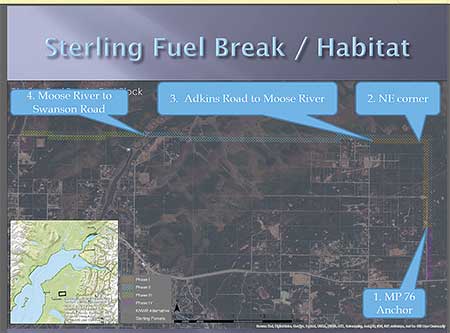
Plans are underway to build a fuel break along the northern and eastern edge of the community. The break is not intended to stop a fire, but to change fire behavior. Rodman said the construction of a fuel break depends on the forest; fire burns very different in different forest types.
“In some cases you might have a shaded fuel break, where some hardwoods remain and shade the forest floor. That keeps the humidity higher, keeps the moisture content of the material on the forest floor higher, so they don’t burn as easily. It helps reduce the effect of wind drying out the forest floor.”
In the Sterling area, with lots of flammable black spruce, the break would be more dramatic. A fire in that area could rage through the crown, she said. “We want to change the fire behavior to something we can deal with. In the case of black spruce, we’d mow it down in a swath 200-feet-wide, and mulch it up. So if a raging fire hit that line, the fire intensity would change. You’d still have some spot fires and fire movement across the line, but we’d have a chance to keep it there. Hit it with retardant and water and fire fighters.”
Matanuska and the Little Granite Creek Prescribed Fire
A prescribed fire was planned for the spring of 2015 in the Little Granite Creek area near the community of Sutton in the Matanuska Valley. In anticipation of the fire, Fish and Game informed area residents about the plans and what to expect, and met with the Sutton Community Council. The Alaska Division of Forestry staff prepped the line. The burn, planned for April or May of 2015, was postponed due to early green up and high humidity.
The fire is desired because the leaves and potential forage on many of the birch and aspen trees in the area are out of reach of moose.
“There are stands of mature aspen there, 50 feet tall and nine inches in diameter, and they’re not providing moose browse,” Rodman said. “If we kill them through fire, you get the sucker response of the shoots coming up. And those shoots are really nutritious to moose. “
Another issue is overgrazed, stunted trees.
“These are 25 years old and have not grown more than about five feet tall,” Rodman said. “Moose keep browsing them every spring and that prevents the tree from growing. And over time, the nutritional quality of the woody stem decreases.”
Rodman said foresters and wildlife managers are hoping the burn can happen in the spring of 2016.
“There is a very specific window when you can ignite a burn,” she said. “We had warm enough temperatures but the humidity wasn’t decreasing, so our fuels weren’t going to be dry enough. It’s a balance of a number of variables. We’d try if we had some of the right conditions, but if the fuels on ground weren’t dry enough to get hot enough, we’d burn up all up all the available fuel without killing the trees, and we’d have nothing to burn next year.
The right conditions for a planned burn
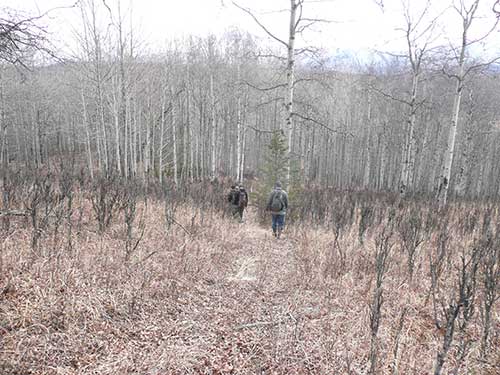
What is the specific window for a burn? Rodman referred to the State Forestry burn plan for the Little Granite Creek Fire.
“Our low (temperature) would be 40, the high would be 70, and the desired temperature is 55 degrees. That affects humidity – the range is 55 to 22 percent, 35 percent humidity is desired. We have a couple things on wind – we want the wind speed at the top of the forest canopy to be between zero and 12 mph, and the desired is seven – we do want some wind.”
Fire managers also account for the wind speed right at the flames. In a raging wildland fire, flames can be 100 to 200 feet high. In a controlled fire flames may be just a few feet high. But flame height is different at the front or head of the fire than it is at the flank. Fire managers planning a burn take a number of parameters into account, including weather, and use a fire behavior model to analyze fire behavior.
The expected flame length for Little Granite Creek controlled fire is 4.1 feet at the head of the fire and 2.3 feet at the flank of fire. Mid flame wind speed is between zero and six mph, with three and a half desired.
“The estimates and values are not exact, but they characterize what can be expected in how the fire moves and how fire managers can control it,” Rodman said.
Tok
Fish and Game is partnering with the Ruffed Grouse Society and the Alaska Division of Forestry to enhance habitat for moose and grouse in the Tok area. This spring, a roller chopper “treated” about 140 acres.
2015 is the first of five years of treatment for the area. Rodman said they planned to treat 200 acres each year, and while they didn’t meet that goal this year, they may make it up.
“We’re learning as we go and getting better as we go,” she said. “We expected do to over 200 acres this year, so more than a thousand acres total over five years. Hopefully closer to 2,000 acres, because we’re able to match some Fish and Game money with funds from the Ruffed Grouse Society, so we can expand our acreages.”
Cameron Carroll, the small game biologist based in Fairbanks, said they are targeting aspen stands with this project. Project managers, including Tok-based biologist Jeff Wells, used a drone to take aerial photographs of the landscape, and will overlay them with maps to help select the most appropriate spots.
“You really want to target aspen, not spruce or willow stands,” she said. “We are planning to do the work later this fall or during early winter. You want to do it when the trees are dormant, when all the nutrients are in the root system, that way they can put it all back into the new growth the next growing season. Aspen regeneration is much more productive if you do the roller chopping in the dormant season. But it’s tricky, coordinating with State Forestry, making sure personnel are available and the conditions are appropriate for roller chopping. We plan to get more done this fall, before there’s too much snow, or in late winter before it warms up.”
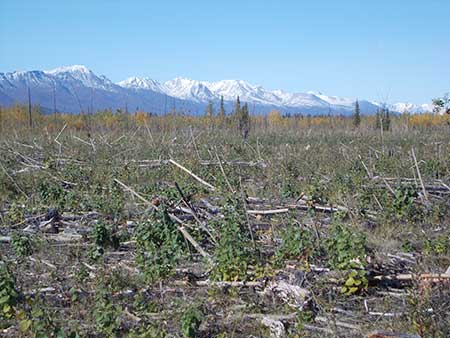
She said aspen stands are coming back in really well following a fire in the area in 1990, and the treatment areas are within those stands of 25-year-old trees.Both ruffed grouse and sharp-tailed grouse may benefit.
“The crushed areas are within those areas, it creates the mosaic of habitat for what grouse need in the different seasons,” she said. “Things are looking really good in Tok.”
State biologist Jeff Wells said the habitat work will benefit the local moose population by creating new browse in an area that is important as wintering habitat. Telemetry work during the late 1980’s found that both migratory and non-migratory moose wintered in the lower Tok River valley, with the migratory portion typically traveling 100-plus miles to areas south of the Alaska Range to calve and to areas within the upper Tok River to rut. In addition, this project is likely to benefit moose hunters both by helping to maintain the current moose population as the 1990 burn ages and also by potentially attracting local moose into areas accessible by highway vehicles or ATVs during the fall hunting season.
Riley Woodford is the editor of Alaska Fish and Wildlife News.
For more on fire, moose and habitat enhancement:
Wild Wonders: Fire (PDF of eight page color magazine for kids)
Kenai Moose and the Funny River Fire
Quest for Fire: Planning a Prescribed Burn
Regeneration Following Fire Creates Fertile Habitat for Wildlife
The Alphabet Hills Prescribed Burn
Firewise Alaska (PDF from Alaska Division of Forestry)
Subscribe to be notified about new issues
Receive a monthly notice about new issues and articles.
